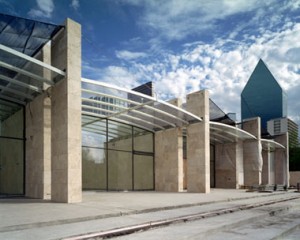Math and Nature
Among other things, math is a tool we can use to understand the natural world. To do that, we need to start with data — often measurements of things we find around us. You and the folks on your tour can try your hand at it right here with the bamboo growing at the corner of the Nasher sculpture center. What are some aspects of the bamboo that we could measure? There are lots: number of leaves on a stalk, height of the first leaf on a stalk, circumference of a stalk, separation of the “joints” on a stalk, and many more. So choose a couple with your participants, and get them to generate data. (I would limit it to just two variables of your choice.) Then you can eyeball the data, or even make a quick, rough scatterplot of the data on your portable whiteboard, to see if there appears to be a relationship between the variables. For example, it appears that the stalks that have longer segments also have larger circumferences. Then you could discuss what the relationship you find, if any, tells you about the plant.
Renzo Piano’s Favorite Ratio
Turning from the natural to the built world, you can tell the tour participants that in the construction of this building, the architect Renzo Piano felt there was one geometric ratio that produced the most pleasing, harmonious forms, so he used it over and over again throughout numerous different features of the building and its rooms. You can ask them to guess what ratio that might have been. You may get guesses of the golden ratio, simply because that is often touted as a ratio that recurs in architecture, or you may get other guesses, or no guesses at all. In any case, once you’ve tried the guessing route, you should suggest that the folks on the tour discover the ratio by measuring things. You will all soon find that the ratio is 2:1, and you can find it in the stones that make up the walls, the paving stones on the sidewalk outside the building, the bays in the front of the building (ignoring the slight arc at the top, they are 32 feet wide and 16 feet tall), and in many other places. I should note that if you look at the main doorway inside one of the bays, you will find that they are 10 feet tall in a half-bay that is 16 feet wide. That’s not a 2:1 ratio, and in fact it is pretty close (between 1% and 2% off) to the golden ratio. That could be a coincidence, or it could be a sly nod to those who adulate the golden ratio in architecture.

